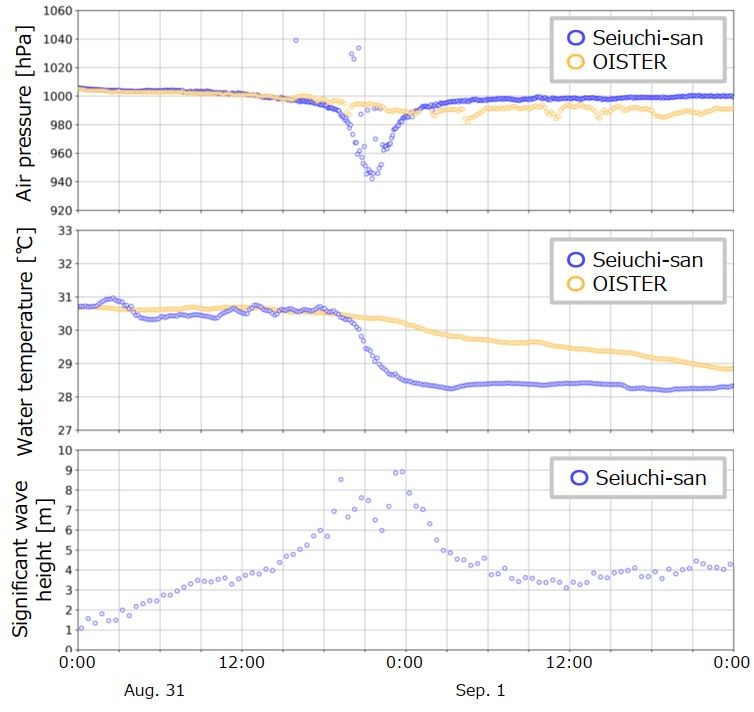Customer
Nippon Telegraph and Telephone Corporation, Okinawa Institute of Science and Technology
Mission Location
Western North Pacific
Highlights
- World’s first oceanographic and atmospheric data collected inside Category 5 Super Typhoon
- Obtaining observational data is critical to improve typhoon intensification and landfall predictions
- Wave Glider SV2 and SV3 were equipped with special payloads and sensors to collect measurements in harsh conditions
“We are working on Super-wide area atmospheric and ocean observations in order to proactively respond to future predictions of the global environment. In particular, in situ observations of the atmosphere and ocean along with observations on a global scale are important to improve the accuracy of weather prediction. Starting with direct observations of typhoons using Wave Gliders, we aim to realize real-time observations of the atmosphere and ocean on a global scale in the future. ”
First Time to Measure Inside Strongest Typhoon Category
Nippon Telegraph and Telephone Corporation Space Environment and Energy Laboratories (NTT) and the Okinawa Institute of Science and Technology (OIST) have successfully conducted the world’s first simultaneous marine and atmospheric measurements directly inside a Category 5 typhoon in the Western North Pacific—the strongest class of typhoons. [Please also refer to the official press release from NTT.]
Stronger Typhoons Require Better Predictions
In recent years, storm systems have become more frequent, stronger, and more destructive due to the effects of climate change. Typhoon research has therefore evolved into a national research priority for Japan, including the establishment of the Typhoon Science and Technology Research Center (TRC) at the Yokohama National University.
To better understand typhoon intensification and enhance landfall predictions, additional data is necessary to supplement satellite imagery. Researchers from OIST and other institutions have conducted various missions over the years to collect in-situ data with the goal to improve the accuracy of typhoon forecasting, including aircraft-based and ocean-based observations.
In 2013, OIST utilized a Wave Glider SV2 named “OISTER” to collect oceanographic and atmospheric data inside a very strong Category 4 typhoon. The mission demonstrated that accurate ocean surface data from within the typhoon is an indispensable component to improve forecasting.
In 2021, NTT and OIST joint forces with the goal to make direct observations in the harsh environment of even stronger typhoons. With the use of a Wave Glider SV3, named Seiuchi-san (translating to “walrus”), the team of researchers equipped the two Wave Gliders with a variety of sensors, including weather stations, a redundant pressure gauge, ADCPs, GPCTDs, and GPSWaves, and embarked on an ambitious mission in summer 2022.
Chasing Super Typhoon Hinnamnor
As Typhoon Hinnamnor was moving west from the island of Minamitorishima on August 28, 2022, it soon turned into a violent Category 5 super typhoon. Wave Glider Seiuchi-san and Wave Glider OISTER were put into action and navigated towards the typhoon. Seiuchi-san collected atmospheric and oceanographic measurements in close proximity (11 km) of the storm’s center, while Wave Glider OISTER operated about 100 km away from the center.
Wave Glider Seiuchi-san gathered remarkable measurements, including average wind speeds of 25 m/s or more inside the storm and wave heights of approximately 9 meters. Sudden and rapid changes in air pressure and water temperature were also observed, both important indicators for estimating the intensity of a typhoon. Wave Glider OISTER, positioned further away from the center, did not experience the same rapid changes in air pressure and water temperature.

While Wave Glider OISTER and Wave Glider Seiuchi-san both experienced drastic conditions, Seiuchi-san recorded a remarkably sudden drop in air pressure and water temperature close to the center of the storm. Credit: NTT/OIST.
Additionally, the researchers collected ocean currents, salt concentrations, and chlorophyll-a data along with operational data of the Wave Glider to improve observation equipment for future missions. The initial results have been published in the Scientific Online Letters on the Atmosphere (SOLA), and a more detailed analysis of the data will be developed.
Future Research Goals
NTT and OIST plan to continue collecting observational data from typhoons to clarify the mechanism between the atmosphere and the ocean inside the storms, and to improve the accuracy of typhoon predications before they reach land. This research is extremely important to increase community resiliency and preparedness by adapting proactively based on highly accurate typhoon predictions.